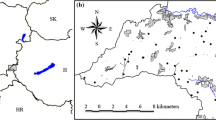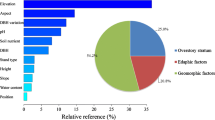Abstract
Sierra Nevada forests have high understory species richness yet we do not know which site factors influence herb and shrub distribution or abundance. We examined the understory of an old-growth mixed-conifer Sierran forest and its distribution in relation to microsite conditions. The forest has high species richness (98 species sampled), most of which are herbs with sparse cover and relatively equal abundance. Shrub cover is highly concentrated in discrete patches. Using overstory tree cover and microsite environmental conditions, four habitats were identified; tree cluster, partial canopy, gap, and rock/shallow soil. Herb and shrub species were strongly linked with habitats. Soil moisture, litter depth and diffuse light were the most significant environmental gradients influencing understory plant distribution. Herb cover was most strongly influenced by soil moisture. Shrub cover is associated with more diffuse light, less direct light, and sites with lower soil moisture. Herb richness is most affected by conditions which influence soil moisture. Richness is positively correlated with litter depth, and negatively correlated with direct light and shrub cover. Disturbance or management practices which change forest floor conditions, shallow soil moisture and direct light are likely to have the strongest effect on Sierran understory abundance and richness.
Similar content being viewed by others
References
P.B. Alaback (1982) ArticleTitleDynamics of understory biomass in Sitka spruce-western hemlock forests of Southeast Alaska Ecology 63 1932–1948
Anonymous 1993. Soil survey of the Sierra National Forest area, California. USDA Forest Service Publication, Clovis, CA, 413 pp.
R.C. Anderson O.L. Louckes A.M. Swain (1969) ArticleTitleHerbaceous response to canopy cover, light intensity and throughfall precipitation in coniferous forests Ecology 50 255–263
M.A. Anderson R.C. Graham G.J. Alyanakian D.Z. Martynn (1995) ArticleTitleLate summer water status of soils and weathered bedrock in a giant sequoia grove Soil Sci 160 415–422 Occurrence Handle1:CAS:528:DyaK28XisV2ltg%3D%3D
R.J. Arkley (1981) ArticleTitleSoil moisture use by mixed conifer forests in a summer-dry climate Soil Sci. Am. J 45 423–427
M.G. Barbour N.H. Berg G.F. Kittel M.E. Kunz (1991) ArticleTitleSnowpack and the distribution of a major vegetation ecotone in the Sierra Nevada of California J. Biogeogr 18 141–149
M.G. Barbour R.A. Minnich (1999) Californian upland forests and woodlands M.G. Barbour W.D. Billings (Eds) North American Terrestrial Vegetation EditionNumber2 Cambridge University Press New York 161–201
E.W. Beals (1984) ArticleTitleBray–Curtis ordination: an effective strategy for analysis of multivariate ecological data Adv. Ecol. Res 14 1–155
P.E. Bress L.C. Wensel (1966) ArticleTitleAspect transformation in site productivity research J. Forest 64 691
T.M. Bonnicksen E.C. Stone (1982) ArticleTitleReconstruction of pre-settlement giant sequoia-mixed conifer forest community using the aggregation approach Ecology 63 1134–1148
Bouldin J.R. (1999). Twentieth-century changes in forests of the Sierra Nevada. Ph.D. Thesis. University of California, Davis, CA, 113.
A. Brandani G.S. Hartshorn G.H. Orians (1988) ArticleTitleInternal heterogeneity of gaps and species richness in Costa Rican tropical wet forest J. Trop. Ecol 4 99–119
L. Breiman J.H. Freidman R.A. Olshen C.J. Stone (1984) Classification and Regression Trees Chapman & Hall New York 483
W.P. Carson S.T.A. Pickett (1990) ArticleTitleRole of resources and disturbance in the organization of an old-field plant community. Ecology 71 226–238
Davis F.W. and Stoms M. 1996. Sierran vegetation: a gap analysis. Sierra Nevada Ecosystem Project: Final Report to Congress, Vol. II. University of California, Davis, CA, Wildland Resources Center Report No. 37, pp. 671–690.
G. De’ath (2002) ArticleTitleMultivariate regression trees: a new technique for modeling species environment relationships Ecology 83 1105–1117
M. Dufrêne P. Legendre (1997) ArticleTitleSpecies assemblages and indicators species: the need for a flexible asymmetrical approach Ecol. Monogr 67 345–366
R. Fiegener (2002) Influence of sampling intensity on the fire history of an oldgrowth Sierra Nevada mixed conifer forest M.Sc Thesis University of California Davis CA 63
L.E. Frelich J.-L. Machado P.B. Reich (2003) ArticleTitleFine-scale environmental variation and structure of understorey plant communities in two old-growth pine forests J. Ecol 9 283–293 Occurrence Handle10.1046/j.1365-2745.2003.00765.x
G.A. Garrison (1949) ArticleTitleUses and modifications for the “moosehorn” crown closure estimator J. Forest 47 73–745
A.N. Gray T.A. Spies (1995) ArticleTitleWater content measurement in decayed wood and forest soils using time domain reflectometry Can J. Forest Res 25 376–385
A.N. Gray T.A. Spies M.J. Ester (2002) ArticleTitleMicroclimate and soil moisture responses to gap formation in coastal Douglas-fir forests Can. J. Forest Res 32 332–343 Occurrence Handle10.1139/x01-200
J.P. Grimes (2002) ArticleTitleDeclining plant diversity: empty niches or functional shifts? J Vegetat. Sci 13 457–460
C.B. Halpern (1988) ArticleTitleEarly successional pathways and the resistance and resilience of forest communities Ecology 69 1703–1715
C.B. Halpern (1989) ArticleTitleEarly successional patterns of forest species: interactions of life history traits and disturbance Ecology 70 704–720
C.B. Halpern T.A. Spies (1995) ArticleTitlePlant species diversity in natural and managed forests of the Pacific Northwest Ecol. Appl 5 913–934
M.E. Harmon (1989) ArticleTitleEffects of bark fragmentation on plant succession on conifer logs in the Picea-Tsuga Forests of Olympic National Park, Washington Am. Midland Natural 121 112–124
M. Henry H. Stevens W.P. Carson (2002) ArticleTitleResource quantity, not resource heterogeneity, maintains plant diversity Ecol. Lett 5 420–426 Occurrence Handle10.1046/j.1461-0248.2002.00333.x
J.C. Hickman (Eds) (1993) The Jepson Manual: Higher Plants of California University of California Press Berkeley, CA 1400
M.T. Hoffman G.F. Midgley R.M. Cowling (1994) ArticleTitlePlant richness is natively related to energy availability in semi-arid southern Africa Biodiversity Lett 2 35–38
K.R. Hubbert J.L. Beyers R.C. Graham (2001) ArticleTitleRoles of weathered bedrock and soil in seasonal water relations of Pinus Jeffreyi and Arctostaphylos patula Can. J. Forest Res 31 1947–1957 Occurrence Handle10.1139/cjfr-31-11-1947
Maser C., Cline S., Cromack K. Jr., Trappe J. and Hansen E. 1988. What we know about large trees that fall to the forest floor. From the forest to the sea: a story of fallen trees. USDA Forest Service PNW-GTR-229, 56 pp.
B. McCune J.B. Grace (2002) Analysis of ecological communities MjM Software Design Gleneden Beach, OR 300
R.A. Minnich M.G. Barbour J.H. Burk R.F. Fernau (1995) ArticleTitleSixty years of change in Californian conifer forests of the San Bernardino Mountains Conserv. Biol 9 902–914 Occurrence Handle10.1046/j.1523-1739.1995.09040902.x
A. Moody R.K. Meentemeyer (2001) ArticleTitleEnvironmental factors influencing spatial patterns of shrub diversity in chaparral, Santa Ynez Mountains, California J. Vegetat. Sci 12 41–52
B.M. Moore B.G. Lee S.M. Davey (1991) ArticleTitleA new method for predicting vegetation distributions using decision tree analysis in a geographic information system Environ. Manage 15 59–71
M. North J. Chen B. Oakley B. Song M. Rudnicki A. Gray J. Innes (2004) ArticleTitleForest stand structure and pattern of old-growth western hemlock/Douglas-fir and mixed-conifer forests Forest Sci 50 299–310
North M., Hurteau M., Figiener R., Barbour M. (in press). Fire and El Niño influences on tree recruitment varies by species in Sierran mixed conifer. Forest Sci.
M. North B. Oakley J. Chen H. Erickson A. Gray A. Izzo D. Johnson S. Ma J. Marra M. Meyer K. Purcell B. Roath T. Rambo D. Rizzo T. Schowalter (2002) Vegetation and ecological characteristics of mixed-conifer and red-fir forests at the Teakettle Experimental Forest USDA Forest Service PSW-GTR-186 Albany, CA 52
C.D. Oliver B.C. Larson (1996) Forest Stand Dynamics, Updated edition John Wiley & Sons Inc New York 520
J.G. Pausas (1994) ArticleTitleSpecies richness patterns in the understory of Pyrenean Pinus sylvestris forest J. Vegetat. Sci 5 517–524
J.G. Pausas M.P. Austin (2001) ArticleTitlePatterns of plant species richness in relation to different environments J. Vegetat. Sci 12 153–166
D.A. Potter (1998) Forested communities of the upper montane in the central and southern Sierra Nevada USDA Forest Service, PSW-GTR-169 Albany, CA 319
P.J. Richerson K.L. Lum (1980) ArticleTitlePatterns of species diversity in California: relations to weather and topography Am. Natural 116 504–536 Occurrence Handle10.1086/283645
E.B. Royce M.G. Barbour (2001) ArticleTitleMediterranean climate effects, I Conifer water use across a Sierra Nevada ecotone. Am. J. Bot 88 911–918 Occurrence Handle11353716
E.B. Royce M.G. Barbour (2001) ArticleTitleMediterranean climate effects, II Conifer growth phenology across a Sierra Nevada ecotone. Am. J. Bot 88 919–932 Occurrence Handle11353717
P.W. Rundel D.J. Parson D.T. Gordon (1988) Montane and subapline vegetation of the Sierra Nevada and Cascade Ranges M.G. Barbour J. Major (Eds) Terrestrial Vegetation of California EditionNumber2 California Native Plant Society Sacramento 559–599
Shevock J.R. 1996. Status of rare and endemic plants. Sierra Nevada Ecosystem Project, Final Report to Congress, Assessments and Scientific Basis for Management Options, vol. II. University of California, Centers for Water and Wildlands Resources Center Report No. 37, pp. 691–709.
Skinner C.N. and Chang C. 1996. Fire regimes, past and present. Sierra Nevada Ecosystem Project, Final Report to Congress, Assessments and Scientific Basis for Management Options, vol. II. University of California, Centers for Water and Wildlands Resources Center Report No. 37, pp. 1041– 1070.
M.P. Vayssieres R.E. Plant B.H. Allen-Diaz (2000) ArticleTitleClassification trees: an alternative nonparametric approach for predicting species distributions J. Vegetat. Sci 11 679–694
M. Vila J. Sardans (1999) ArticleTitlePlant competition in Mediterra-nean-type vegetation J. Vegetat. Sci 10 281–294
Author information
Authors and Affiliations
Corresponding author
Rights and permissions
About this article
Cite this article
North, M., Oakley, B., Fiegener, R. et al. Influence of light and soil moisture on Sierran mixed-conifer understory communities. Plant Ecol 177, 13–24 (2005). https://doi.org/10.1007/s11258-005-2270-3
Received:
Accepted:
Issue Date:
DOI: https://doi.org/10.1007/s11258-005-2270-3




